Who Is Kim Hellberg?
Back in June, we ran an analysis of a small club in Sweden that had asserted itself as the most tactically sophisticated team in the Allsvenskan.
Despite the lowest budget in the league, IFK Värnamo managed a 10th-place finish a year after earning a promotion to the top tier.
At the helm of this tactically innovative side is 34-year-old Kim Hellberg, who is assisted by Total Football Analysis’ first-ever senior analyst, David Selini.
To compete with the biggest clubs in the country, Värnamo have to be a little different.
This is where Hellberg differentiates himself from the pack.
Rather than leaning on widely practised tactics, he has found a way to narrow the gap with an innovative game model that allows for a high degree of tactical adaptability.
His side is one of the most enjoyable squads you’ll see.
One tactical analysis on the club wasn’t enough to address Hellberg’s approach.
This article should be paired with the last discussion on his tactics.
Between the two, you’ll see a tactically flexible side playing a high-tempo style with a very aggressive approach on both sides of the ball.
Kim Hellberg Tactics & Formations
Check any data provider or lineup visualizations and you’ll come away with the impression that Värnamo typically plays with a back four and some variation of a three-man midfield.
4-2-3-1 is the most common system of record, followed by 4-3-3 and a 4-1-4-1.
Clean representations of systems are easy to grasp.
Plus, they typically give an idea of the spaces and relationships teams hope to exploit.
But the system is a little more than numbers at Värnamo.
Rather than talking about formations, they speak of adapting their positioning based on the opposition’s defensive setup.
Zonal marking structures are most commonly used by Allsvenskan clubs, meaning each matchup presents specific spaces Värnamo can attack with higher degrees of success.
The game model has very clear principles which are coupled with a high degree of adaptability based on the opposition’s style of play.
One of Hellberg’s greatest strengths as a manager is that his teams can seamlessly adapt their tactics in the flow of play.
Värnamo can show a variety of tactical setups and switch between attacking patterns in the flow of play, which keeps opponents off balance, but that attacking variability starts with their rest defence.
This is especially the case among the back five.
Whether Hellberg has set up his men in a three or four-back system, the backline and holding midfielder will either set up in a 3-2 or 2-3.
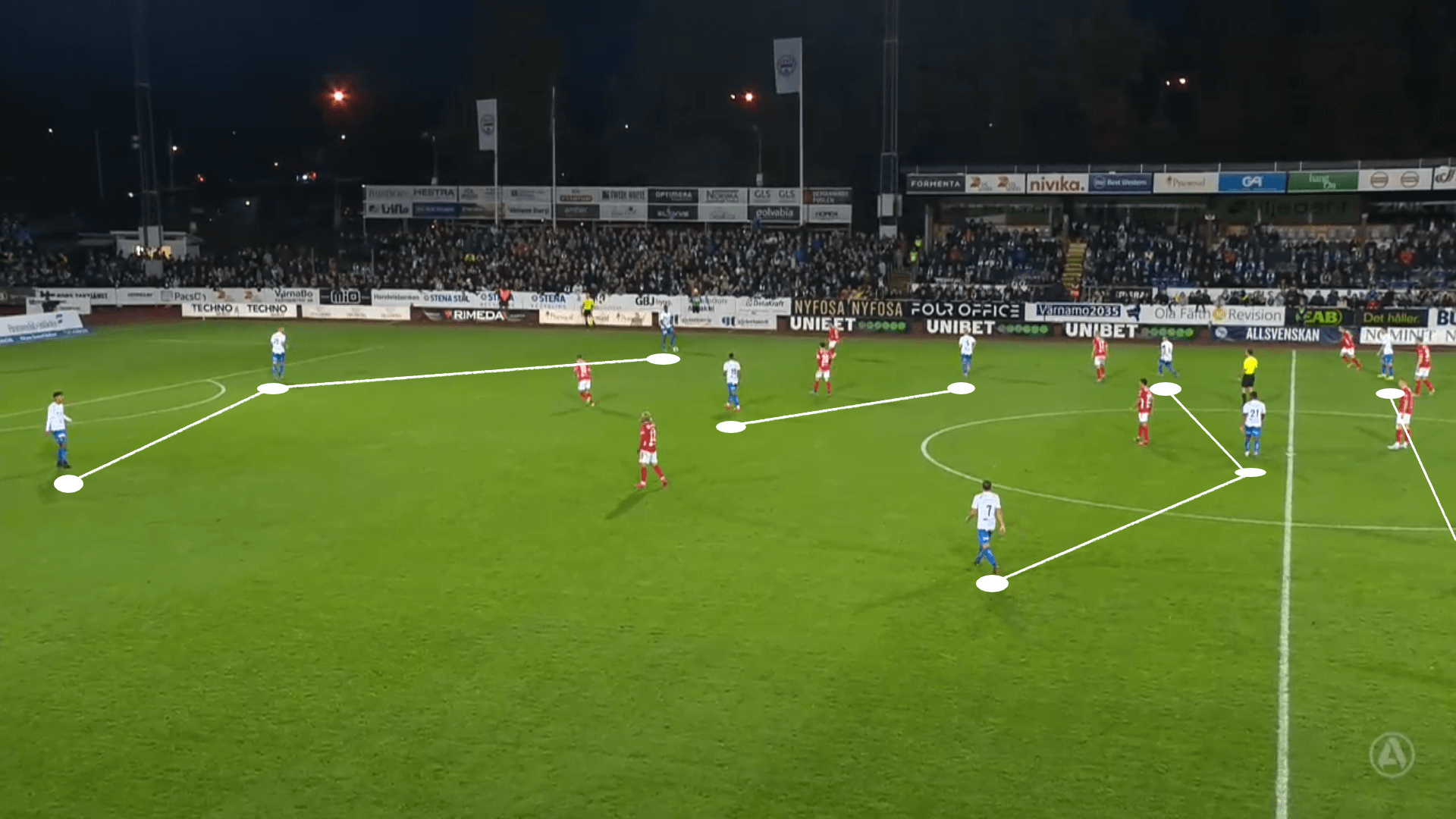
Of the five highest-positioned players, one player will offer width on either side of the pitch with two #10s playing more centrally in support of the #9.
Those three central players have a lot of freedom to work off of each other.
One will often remain higher than the other two while the others search for space between the lines.
Dynamic positional rotations are common as Värnamo look to stretch the backline and then check back into the space between the lines.
Regardless of the attacking phase, Värnamo will look to control the middle of the pitch.
Central overloads allow them to unbalance the opposition centrally, creating space for progression through the wings.
If the opponent doesn’t respect the central overload, Värnamo is quick to attack it.
The other advantage is that, if the ball is lost, Värnamo is well positioned to counterpress and contain the opposition’s counterattack.
Their rest defence shows the commitment to central dominance.
For example in the late season match against Norrkoping, a nominal 4-1-4-1 setup transformed into a 3-2-5 in the middle third.
Vindehall, the right back, push high up the pitch while the remaining three defenders slid into a back three.
With the 3-2 in place at the back, the deep structure created attacking freedom for the front five.
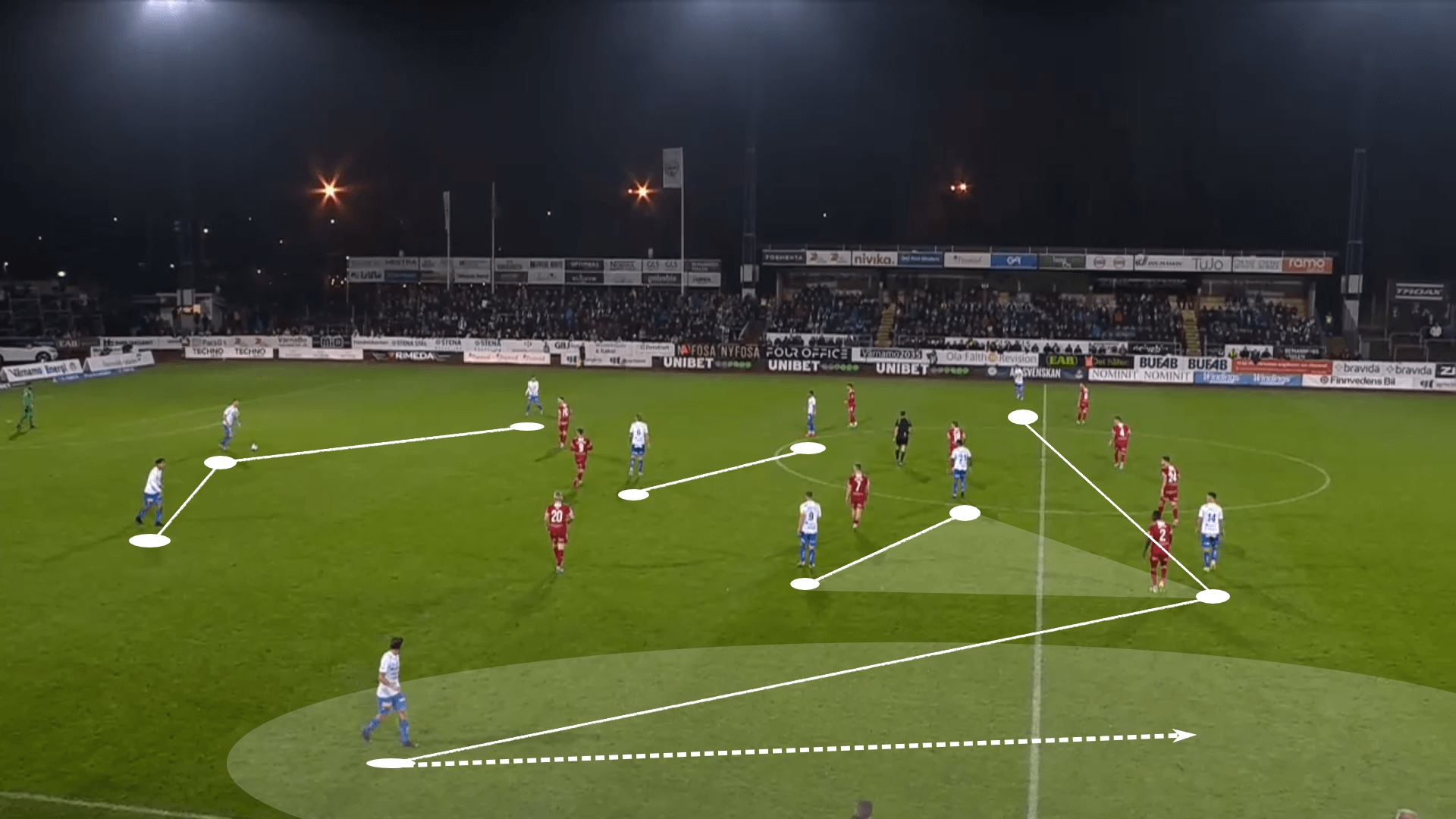
Part of their tactical flexibility is due to the implementation of “free centre-backs.” A bit of a novelty in the game, the concept of free centre-backs allows for one of the centre-backs to alternate between the backline and midfield based on specific attacking or defensive phases.
Hampus Näsström, with the long blonde hair, is operating as a #6 in a double pivot at the moment, but as the opponent gains possession and moves into the final third, he has the freedom to drop between the centre-backs to add an extra layer of protection against crosses.
As the team regains possession, he then has the freedom to push forward into midfield.
His role is very much a hybrid of the two positions.
In the match against Norrkoping, his positioning was more aligned with that of a #6, but his role was adaptable based on the needs of the opposition and very specific given the game phase.
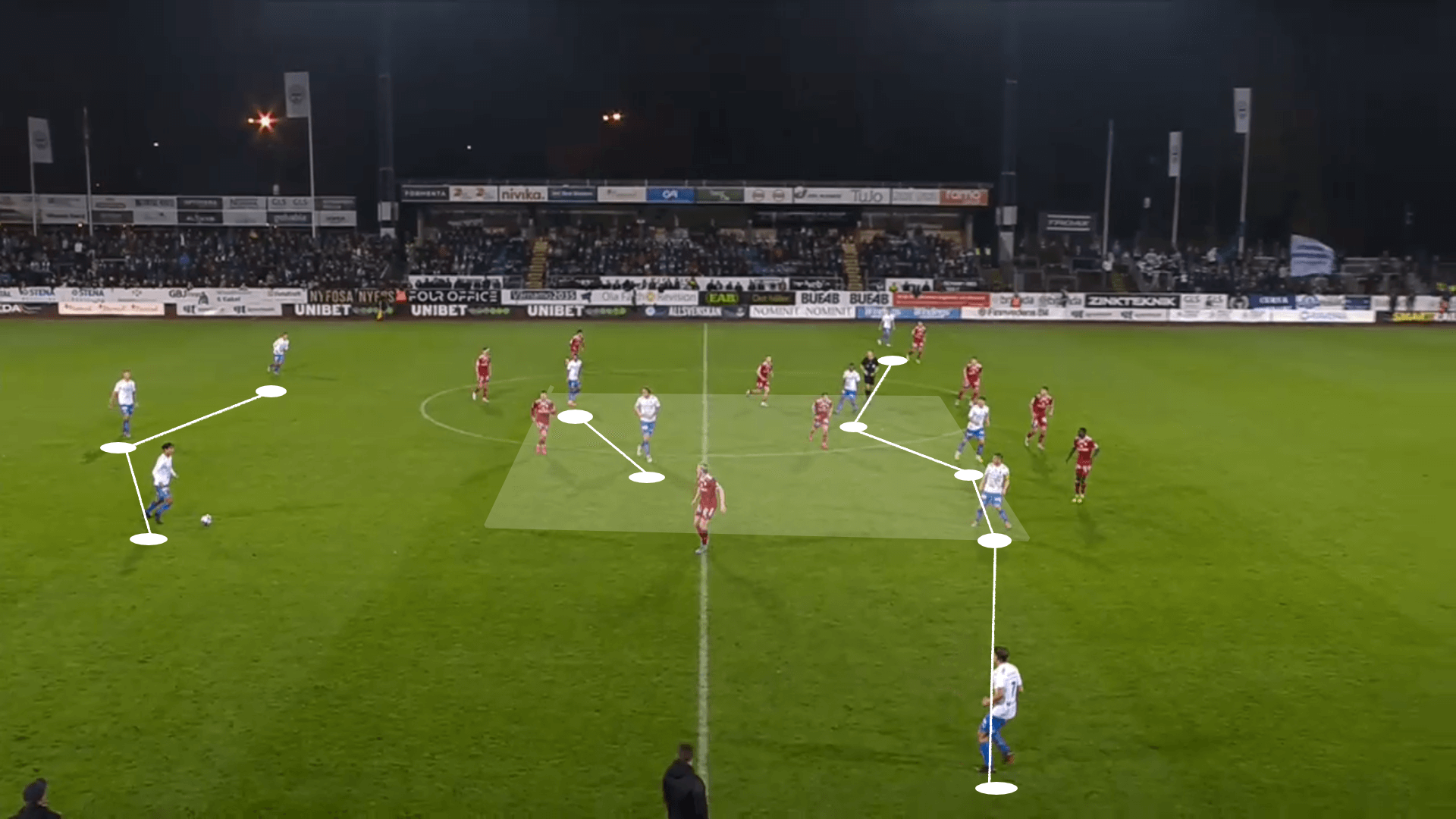
One of the principles in play is that it’s easier and safer to recover into the backline than it is to direct momentum away from goal into midfield.
With the double-pivot closely linked with the back three, Näsström is well-positioned to remain in midfield in support of the higher players or drop into the backline when he anticipates a need for his aerial prowess.
In general, when in possession, the free centre-back will take a central role in midfield, adding to the opponent’s need to commit numbers to the interior channels.
Looking at Värnamo’s ball progression map from the 2022 Allsvenskan season, there’s an indication of the central overload’s role in creating wide attacking opportunities.
The data visualization shows progressive runs and dribbles, both successful and unsuccessful.
The club did well to find their high, wide attackers in high percentage attacking situations.
The attacking half of the pitch is heavily lined with the grey lines signifying progressive runs.
Pushing into the final third, the map lights up with 1v1 duels.
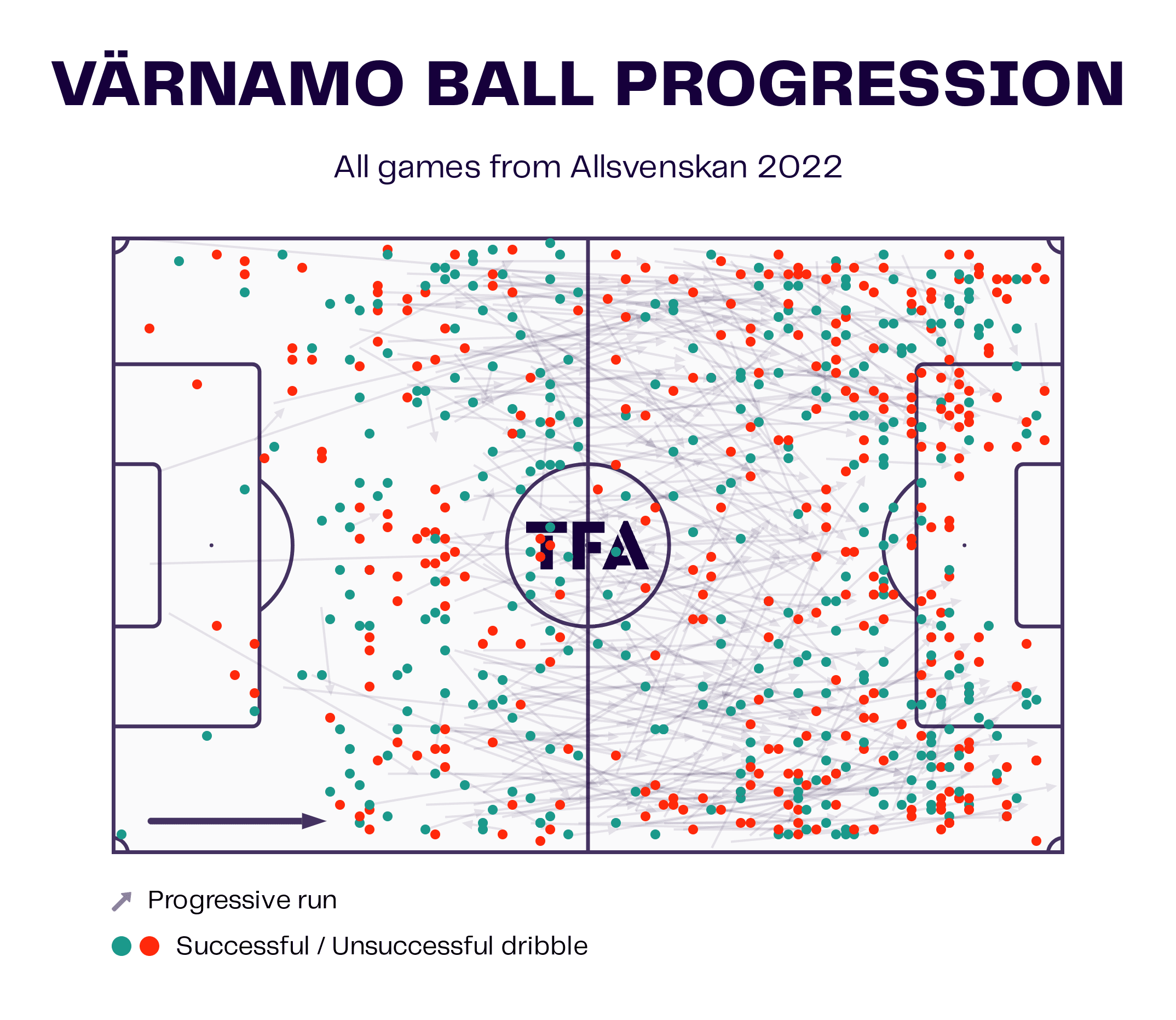
Värnamo’s central threat forces the opposition to commit numbers in the middle of the pitch, creating space for the wingers to run unopposed into the final 20 m of the pitch or to attack a 1v1 situation with limited to no support for the first defender.
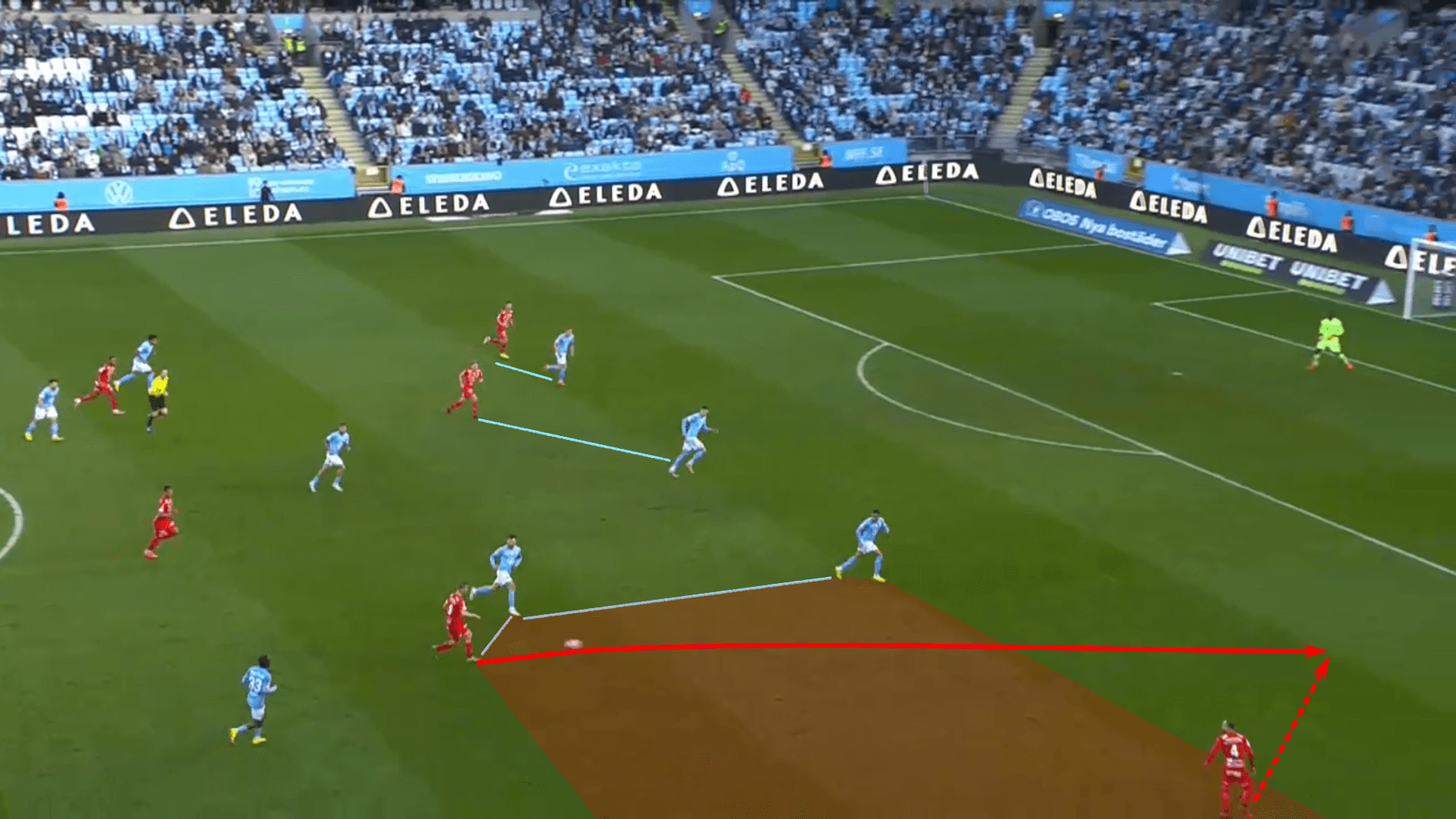
As the ball is played wide, the opponent must send at least one player to slow the Värnamo attack.
But as the defending team’s defensive structure shifts to adapt to the ball’s new location and the threat of box entry through the wing, Värnamo’s central players spring into action with methodical runs into the box.
Given the number of players they commit to high central positions, they often attack the box with numeric equality, increasing the likelihood of latching onto the wide service.
The approach is very much in line with the modern game and helped Sweden’s smallest first-division club to a mid-table finish.
Verticality and direct possession
When teams are described as direct, the perception is normally that the side is playing Route 1 or playing off of a traditional target man, scrounging for second balls.
It’s disorderly, chaotic and aesthetically unpleasing.
Värnamo’s style of play is very vertical, but far from the traditional meaning of direct.
Rather than a hit-and-hope approach, Värnamo is a side that uses numeric overloads to ruthlessly break lines and run at the opponent.
They’re not afraid to play over the opposition with thoughtful passes into streaking wingers, but their most modus operandi is to play into high targets between the lines while keeping the ball on the ground.
Let’s walk through the setup.
Hellberg’s side is very intentional when building out of the back.
The distance between the first and second lines is tight while the gap between the second and third tends to be more expansive.
The objective is to bait the opponent high up the pitch while creating space between the lines to bypass the first wave of the press.
In the first image, we see the 3-2 set up at the back, then a large gap.
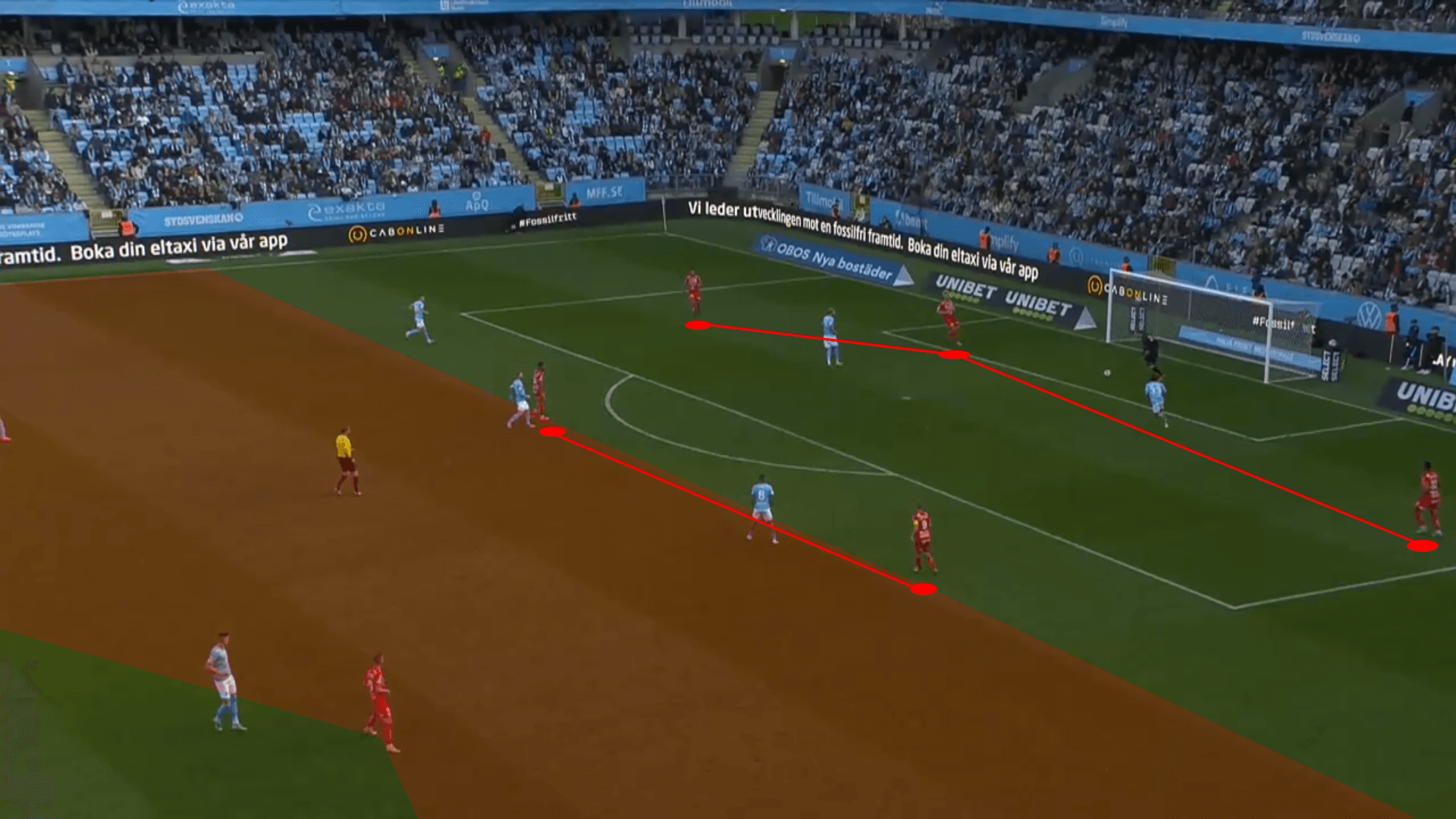
When it is time to play forward, the five players higher up the pitch typically have more space to work with.
In a perfect scenario, the build-out is creating numeric equality higher up the pitch while forcing the opposition to cover a lot of ground.
In this instance, Malmö was forced to cover the width of the pitch.
The two Värnamo #10s split off into the half-space creating a 1v1 centrally for Filipp Voytekhovic’s pass into Marcus Antonsson.
Once the pass was made, the two #10s raced into support positions, allowing their striker to set the ball into them.
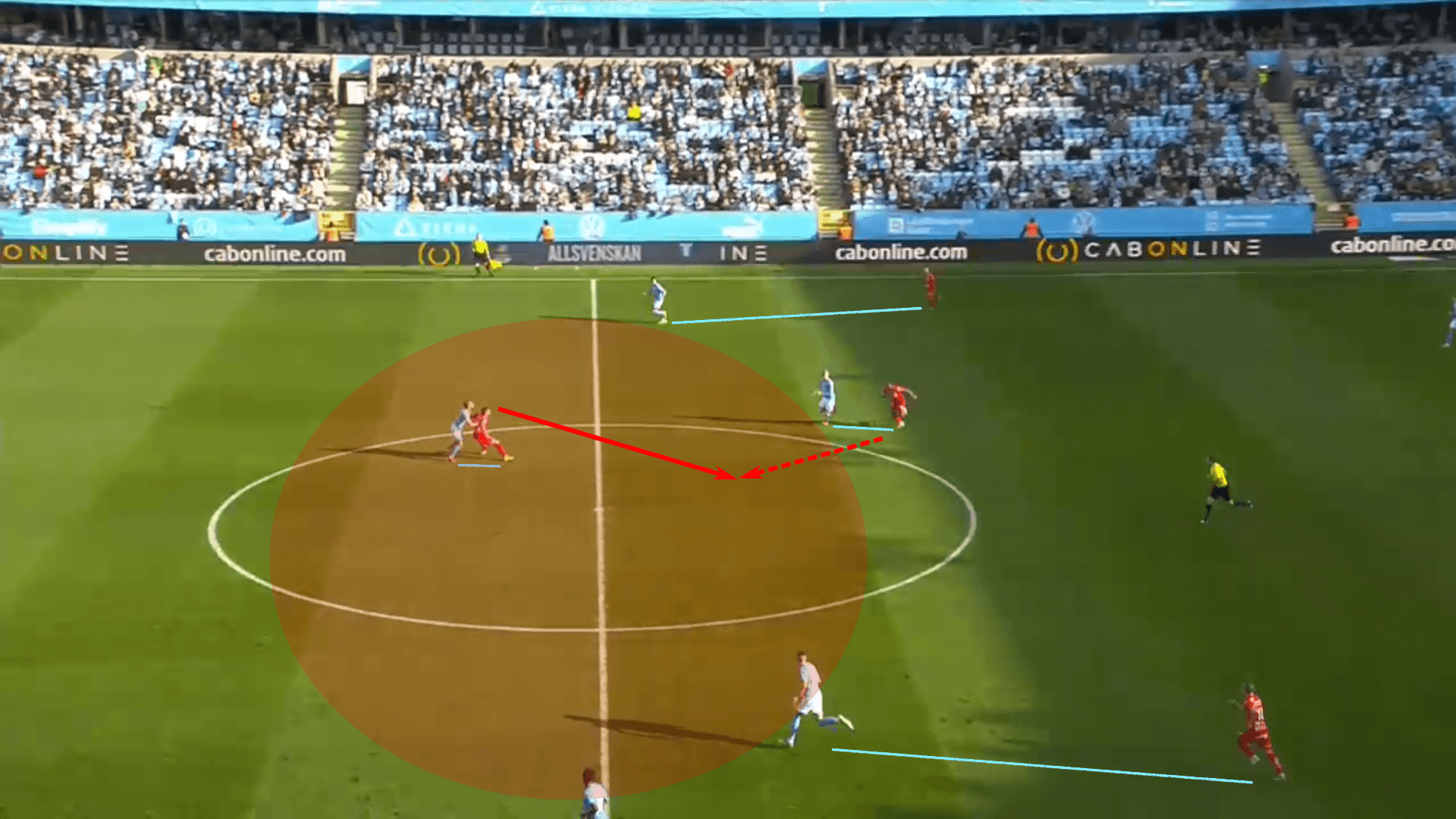
Setting the ball into players in support positions is critical for Värnamo’s success.
Their moves to goal are very quick, catching the opposition before they can get organized.
Getting the two attacking midfielders in support positions beneath the striker allows them to set the ball into the path of a player with forward-facing body orientation.
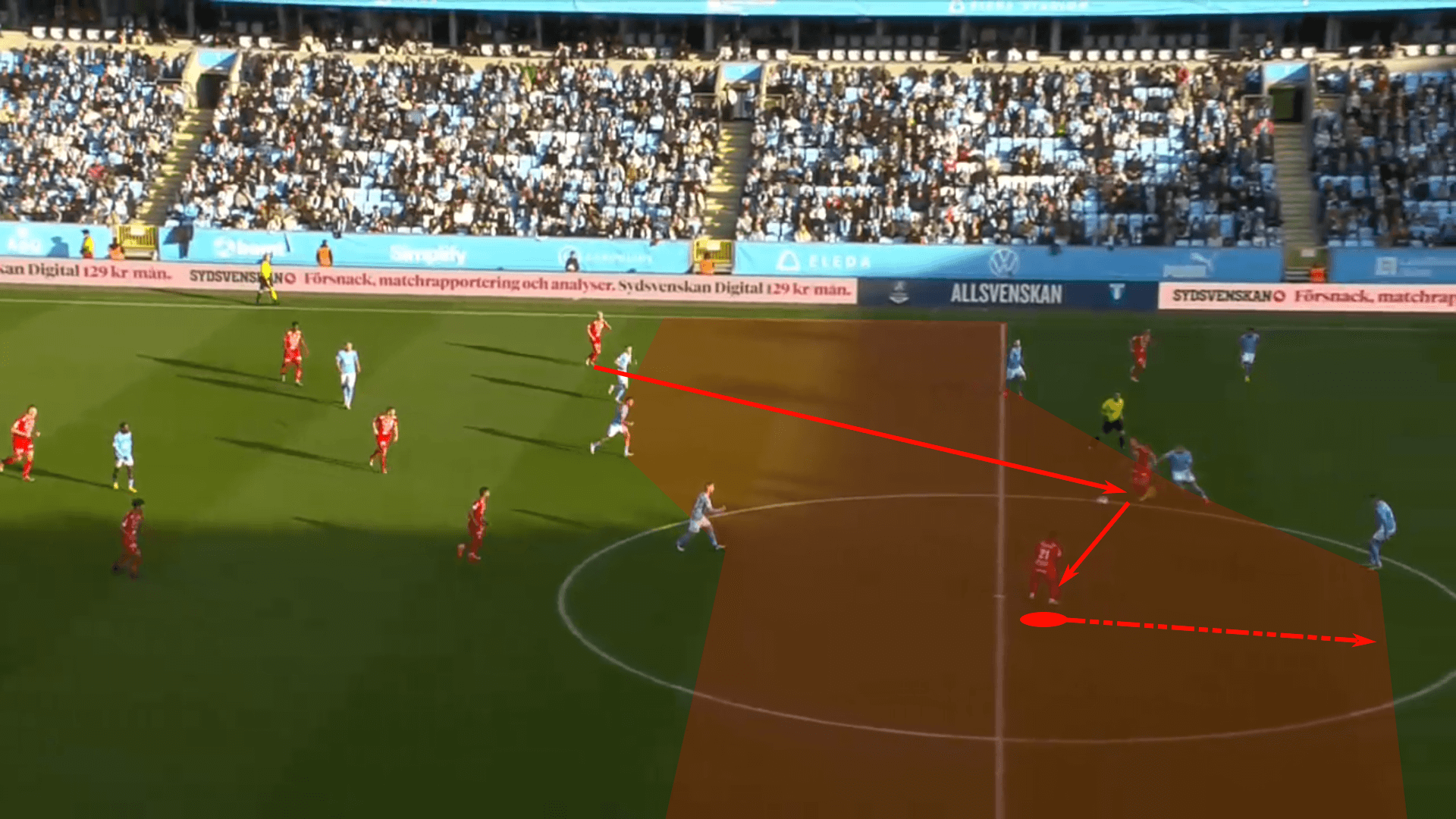
The simple up/back pattern is designed to put the dynamic playmakers in forward-facing positions with support options in front of them.
If the opposition’s outside backs have been recovered into the backline, Värnamo’s midfielders can look to play their wingers behind the backline into uncontested space.
In an instance when the ball is played into the central overload between the lines, Värnamo will increase the tempo to run at the opposition.
If the response is to drop off, Värnamo will use a variety of runs to either get him behind or optimize space for a potential 1v1 duel.
Should the centre-back step into midfield to aggressively engage, Hellberg’s #10s are typically very proficient on the dribble.
Opposing centre-backs may step into midfield, but they do so at their own peril.
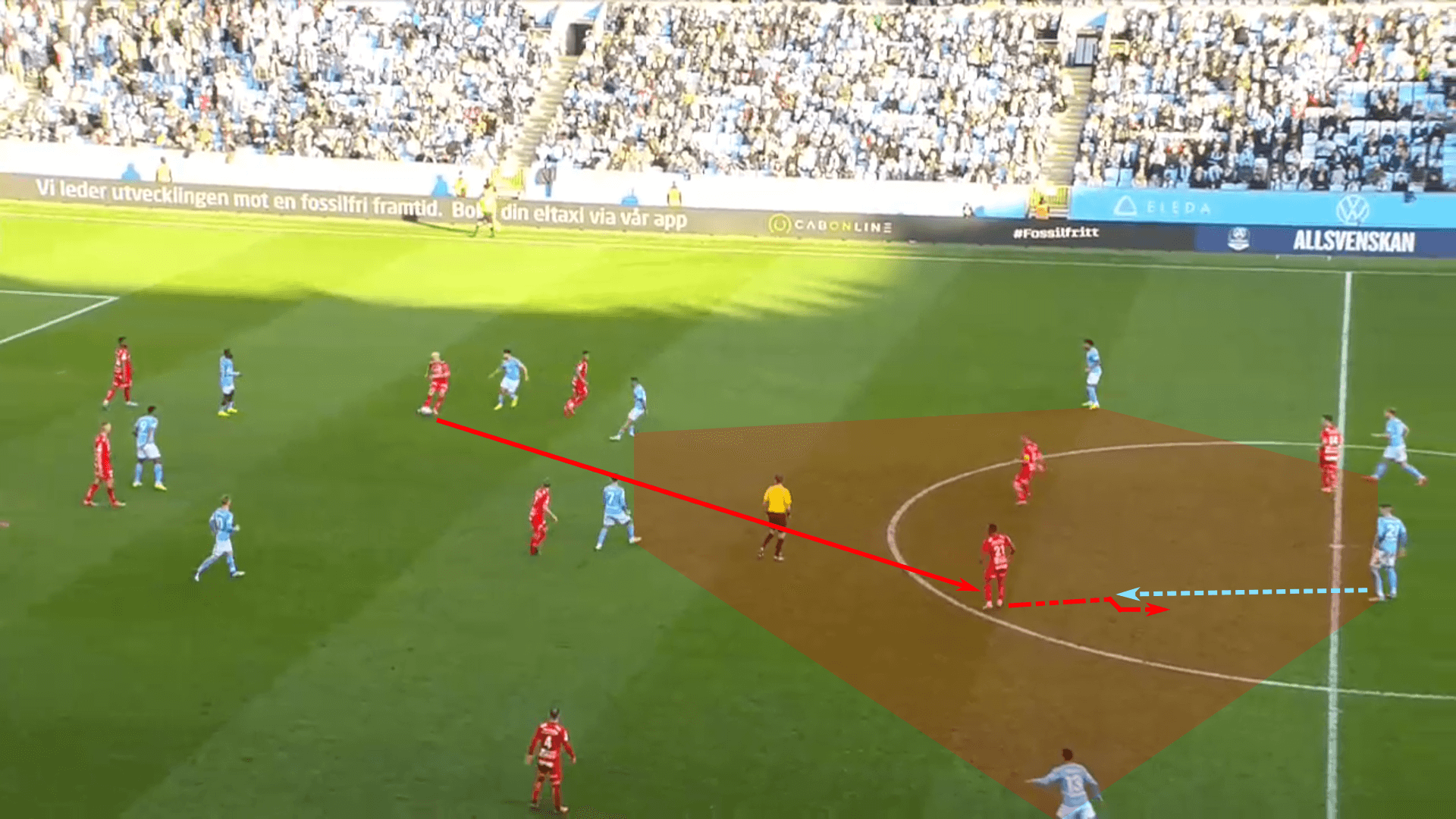
In this instance against Malmö, Abdussalam Magashy won his 1v1 against Dennis Hadžikadunić, bursting into the attacking half of the pitch, and setting up a direct attack.
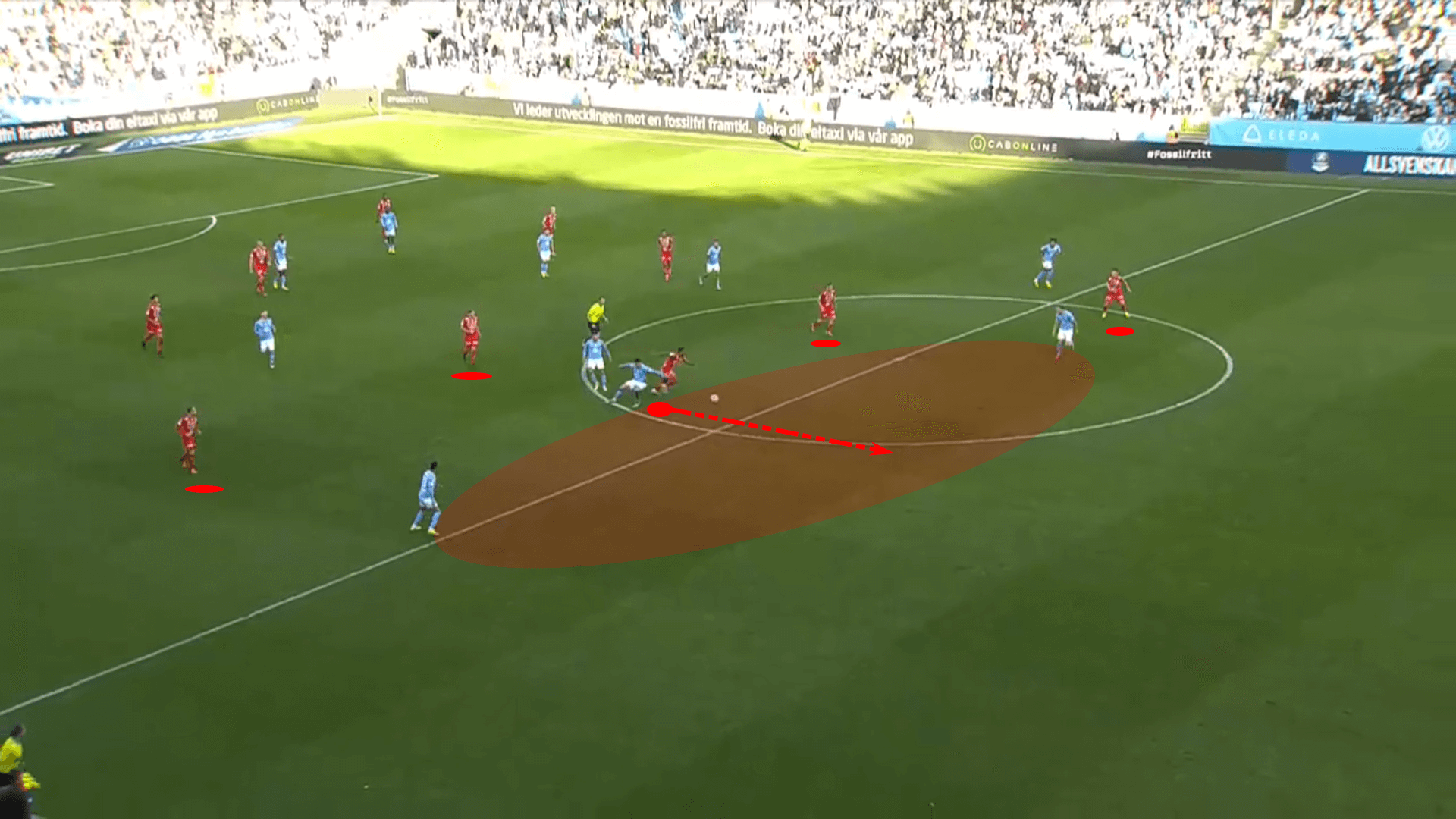
Hellberg’s Värnamo is direct in the sense of the efficiency of their passes to break lines.
They will systematically break opponents down, creating gaps between the lines and space to run behind the opposition.
It’s the kind of direct possession tactics that I touched upon in a previous magazine article.
They are not interested in 50-pass sequences leading to a shot.
The sooner they can generate the goal-scoring opportunity the better because that’s ultimately the best opportunity to catch the opposition’s press in a disorganized state and exploit their systemic weaknesses.
One of the difficulties in facing Värnamo is that their central dominance forces opponents to become unbalanced centrally, which then creates space for wing progressions.
Looking at the Värnamo pass map from the 2022 campaign, there’s a lot of movement as they enter the middle third, then a gap in the colouration before the wings light up in the opponent’s half of the pitch.
More ball progressions occurred on the right side and the height of the reception showed more variability.
On the left-hand side, there were fewer passes overall, but they did generally receive the ball higher up the pitch.
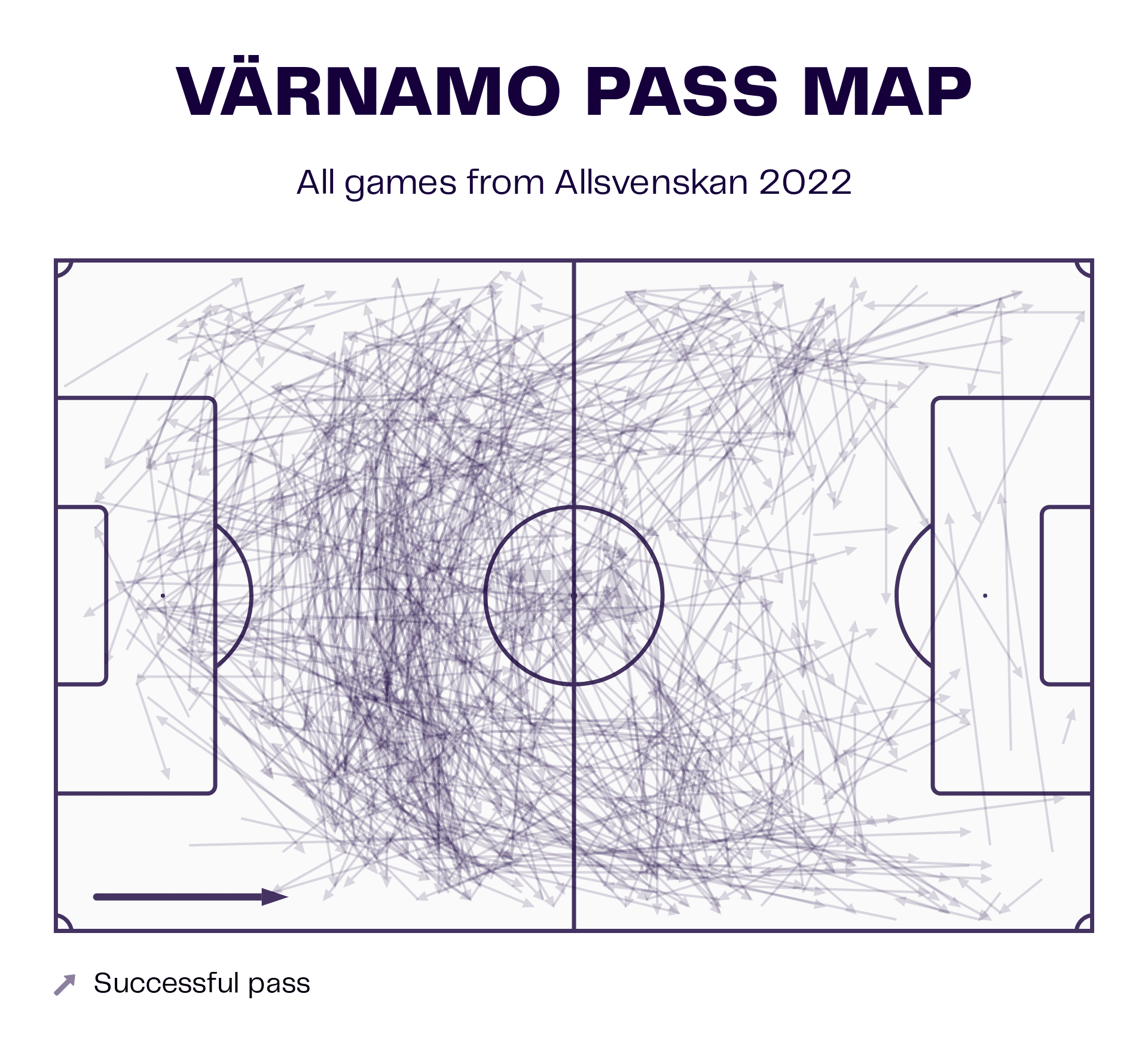
In Hellberg’s game model, the starting position of the two wingers is designed to manipulate the positioning of the opposition’s deepest wing player.
Should the opponent use a back three with wingbacks, Värnamo’s two wing players will take up higher positions to pin the opponent back and offer runs in behind.
Against a back four, the wing players will still look to get him behind, but they’re also well-drilled and on how to bait the opposing outside-backs higher up the pitch, which creates the space they want to attack.
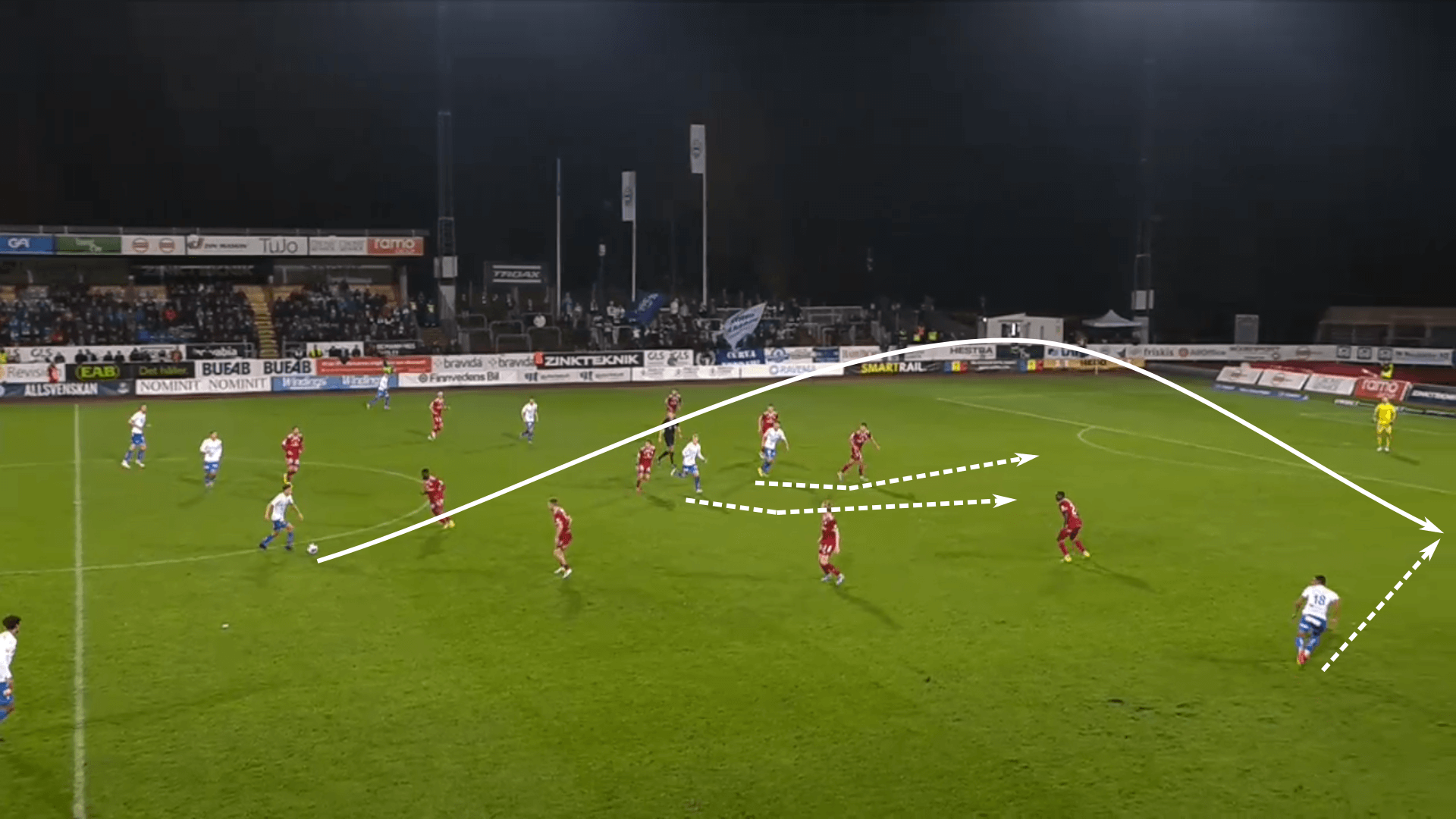
Once Värnamo plays into the wings, opponents are forced to slide their lines wide while also dropping off as Hellberg’s men storm the goal.
Yet again we can see the connection with the high central overload.
In the final image of this section, Näsström plays Wenderson behind the backline.
Norrköping naturally shift their attention to the immediate threat, sliding to Wenderson.
The actual goal is one of the more bizarre ones you’ll see as Wenderson hits the post only to see the ball deflect off of his defender on the goal line, sending the ball over the goalie, past the near post and into the waiting path of Antonsson, who finished from about a yard off the line.
Värnamo’s verticality and direct possession, coupled with their high central overload create quite a predicament for opponents.
Move centrally and watch Värnamo attack the wings.
Try to remain balanced and Hellberg’s side will pick you apart centrally.
It really is a matter of picking your poison.
Aggressive pressing
An aggressive press typically correlates to a low PPDA rate.
The thought is that an aggressive press will typically lead to a quicker regain.
Counterpressing factors in, but the general demeanour of the defensive tactics features a relentless pursuit of the ball.
At 12.28 PPDA, that’s not the type of aggressive pressing we see from Värnamo.
That PPDA ranked 11th in the Allsvenskan during the 2022 season.
Rather than the rate of regaining possession, the aggression of their tactics is more closely related to their structure.
The defensive territory chart maps out the club’s defensive actions, interceptions, and fouls during the previous season.
The rectangular area shows the typical area of engagement while the double line just below midfield marks out the average height of recoveries.
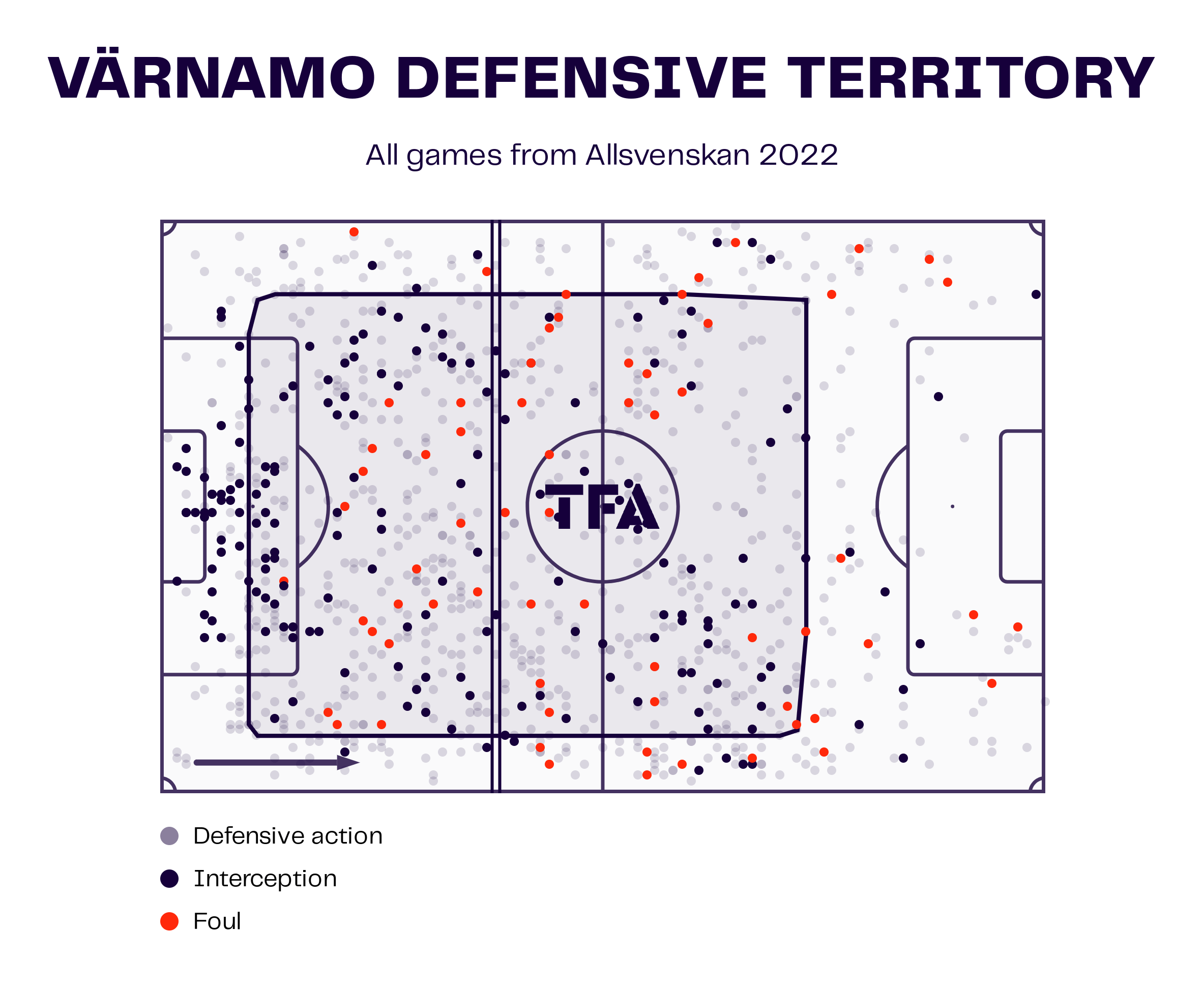
While attacking third recoveries are infrequent, it’s the work they do high up the pitch that produces many of the club’s middle third recoveries.
Even on the high regains map, we find that the recoveries increase significantly once the opponent plays into the middle third.
Värnamo will counterpress and have their share of dangerous recoveries, but the overall pressing structure is designed to allow opponents to move into a more expansive attacking shape, and then exploit the ground conceded upon recovering the ball.
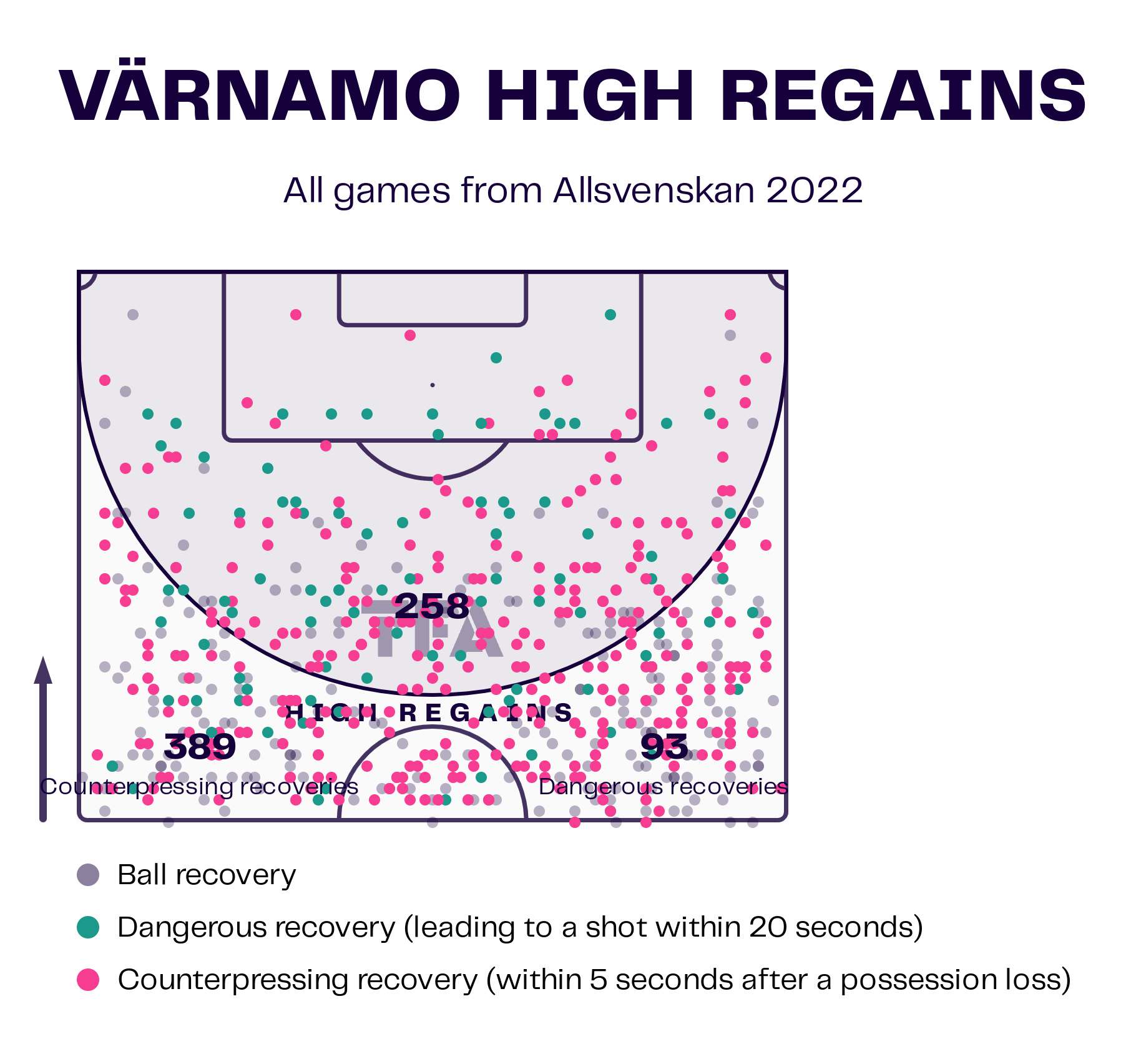
Let’s take a look at an example against Kalmar.
The white lines show the landmarking responsibilities of each Värnamo player.
Cutting off all short and intermediate passing options, Hellberg’s side funnelled the attack into Kalmar’s goalkeeper, Jakob Kindberg, forcing him to essentially clear the ball from his own six-yard box.
The result of the sequence was a Värnamo middle recovery.
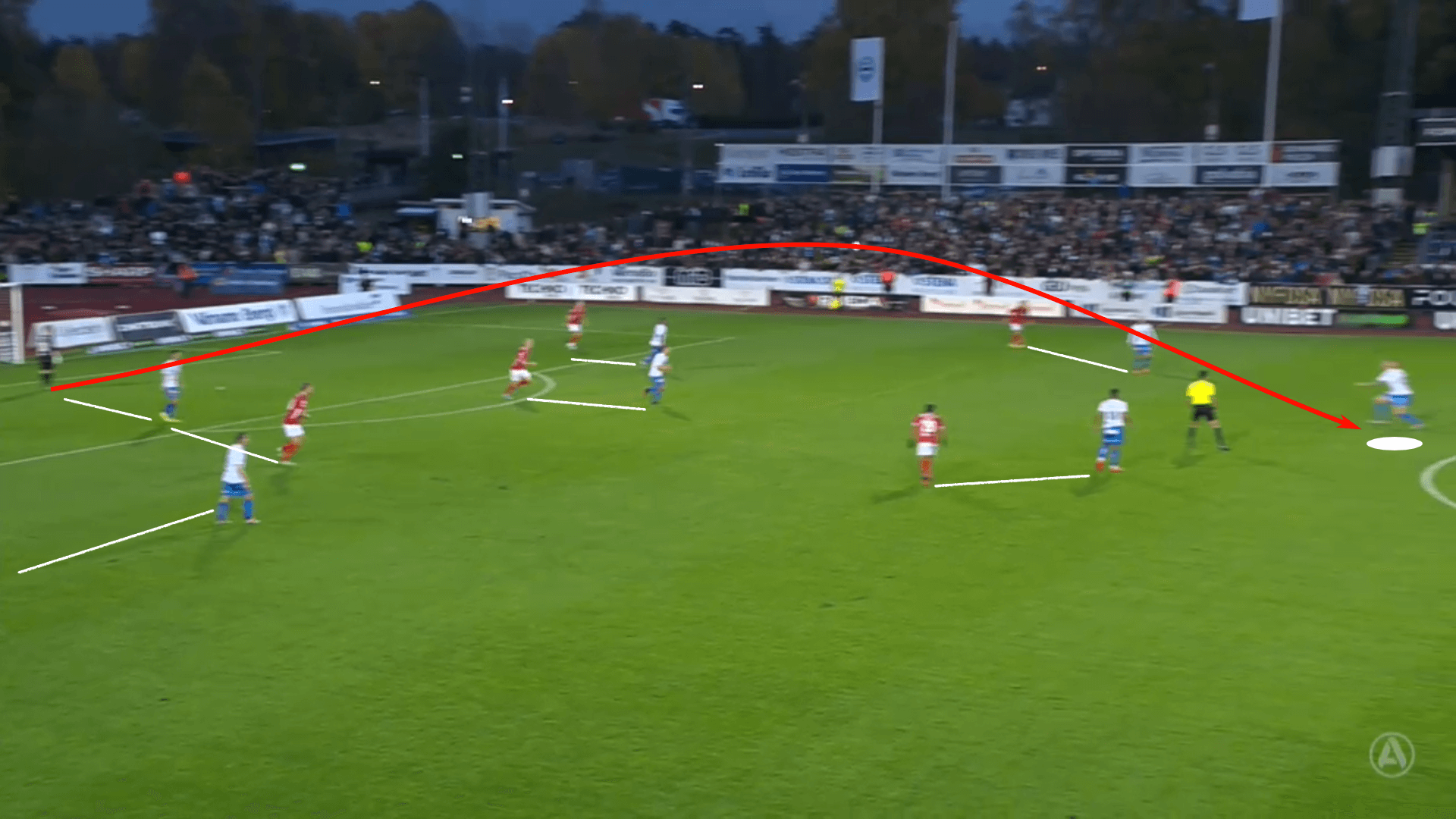
The pressing scheme is very heavily ball-oriented and can give the impression of a man marking approach.
Short and intermediate options in midfield are eliminated and two attackers are often kept high to cover the opposition’s centre-backs, forcing opponents to play safe during their build-out before hitting a hopeful ball forward.
The predictability of that sequence allowed Värnamo’s backline and deeper midfielders to prepare for lofted balls played forward.
In the second example, we not only see the 4-4-2 setup from Hellberg’s side, this time in the red kits, but we also see the positional orientation of the midfielders.
Short and intermediate opponents are tightly marked while allowing their marks to stay ball-side.
The centre-backs can play to midfield if they’re willing to risk the pass under heavy pressure, but the likelier outcome will always be the longer-range target.
When that lofted pass is played forward, Värnamo’s midfield gains a positional advantage by recovering into a ball-side position, giving them the advantage in winning the second ball.
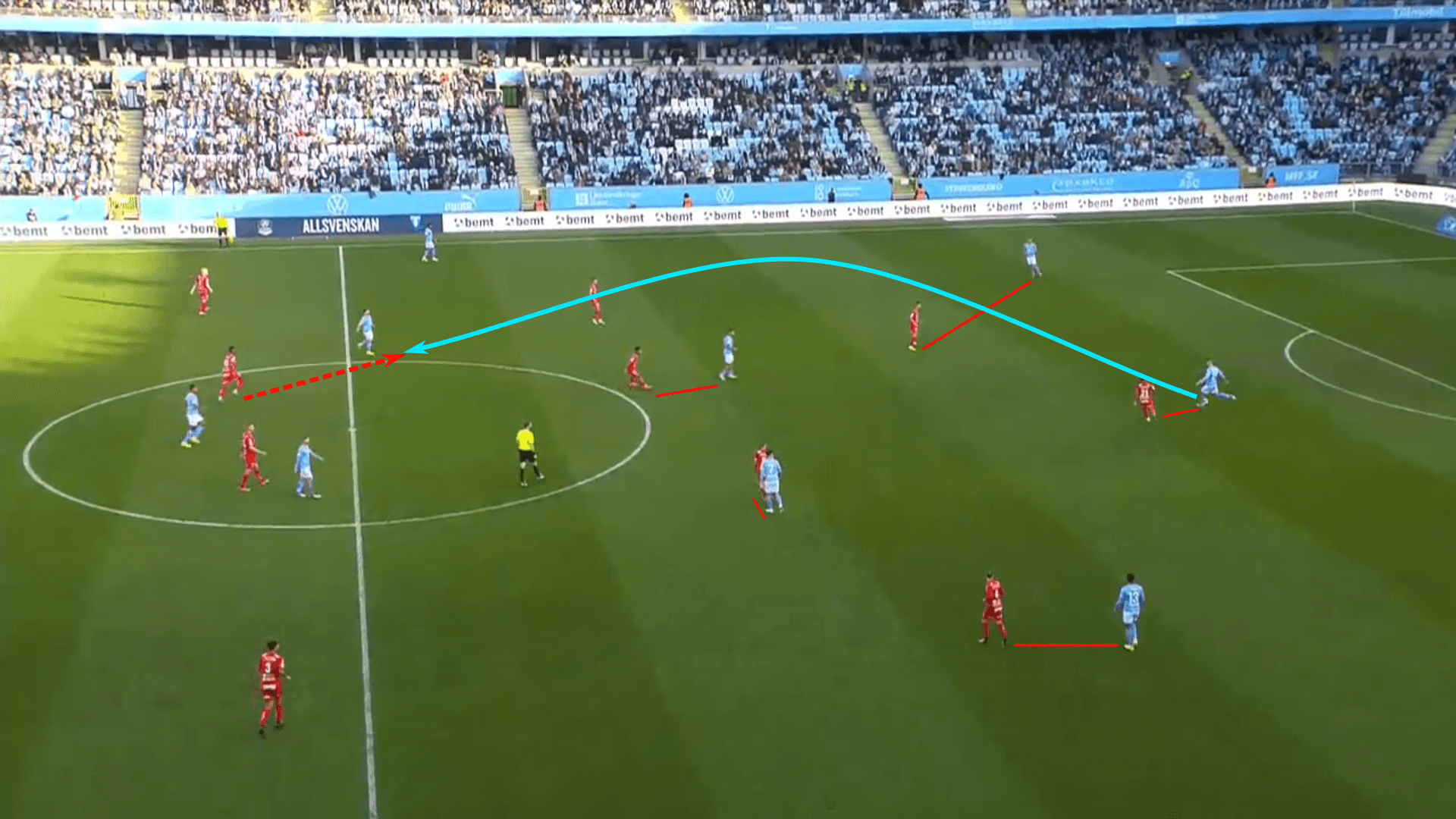
The third example is very close to the second but shows the defensive tactics from a deeper part of the pitch.
At this point, the approach is more zonal and Värnamo are braced for the long, central ball.
Värnamo drop the backline deeper to keep the ball in front of them and shift into a 5-3-2.
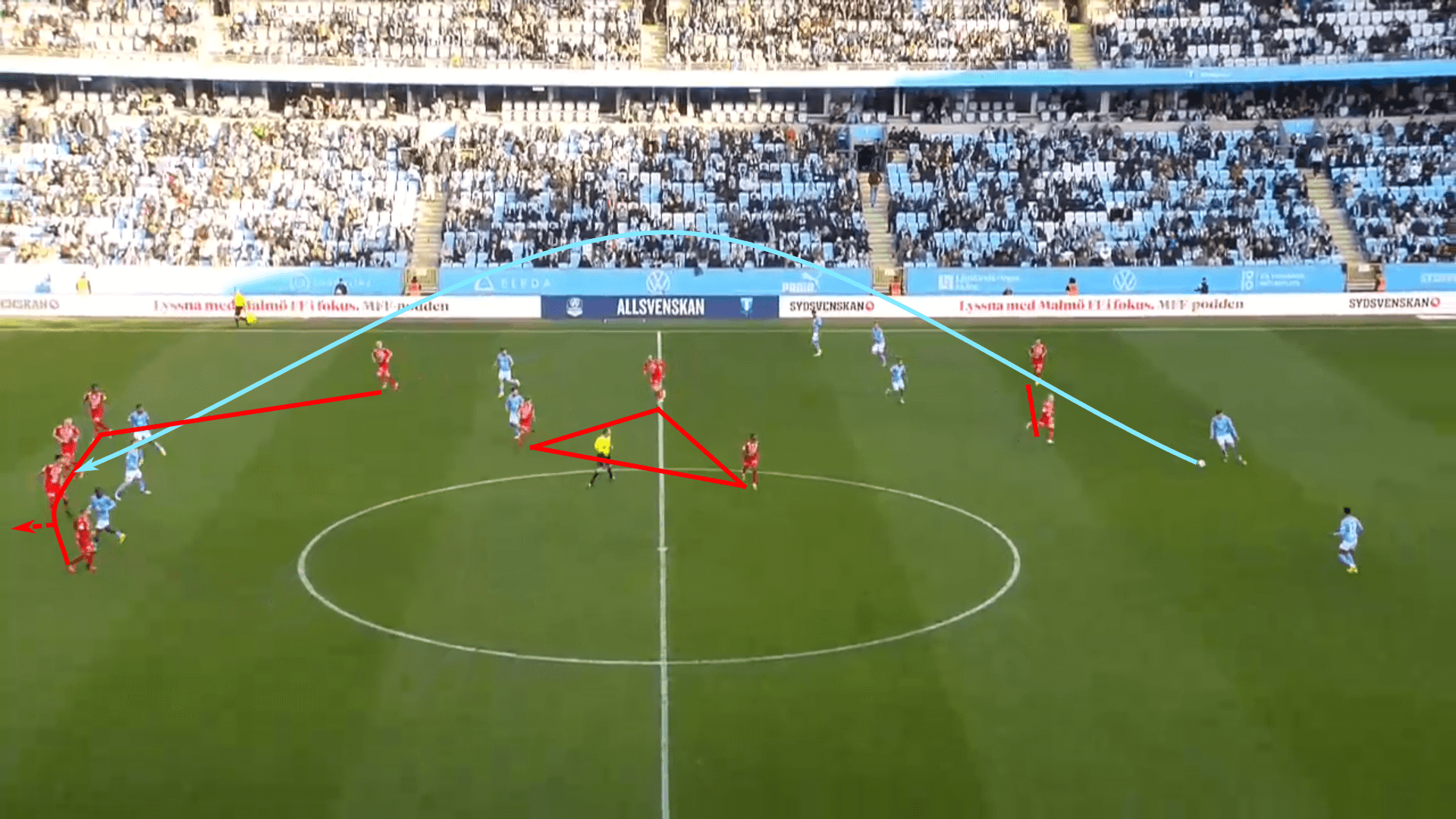
The move is successful, allowing Robin Tihi to move forward to meet the header.
Coming forward to meet the ball rather than retreating increases the likelihood of his aerial duel win through his positional advantage and improving his approach to the jump.
The result of the play is an aerial win for Värnamo and a counterattacking opportunity for the visitors.
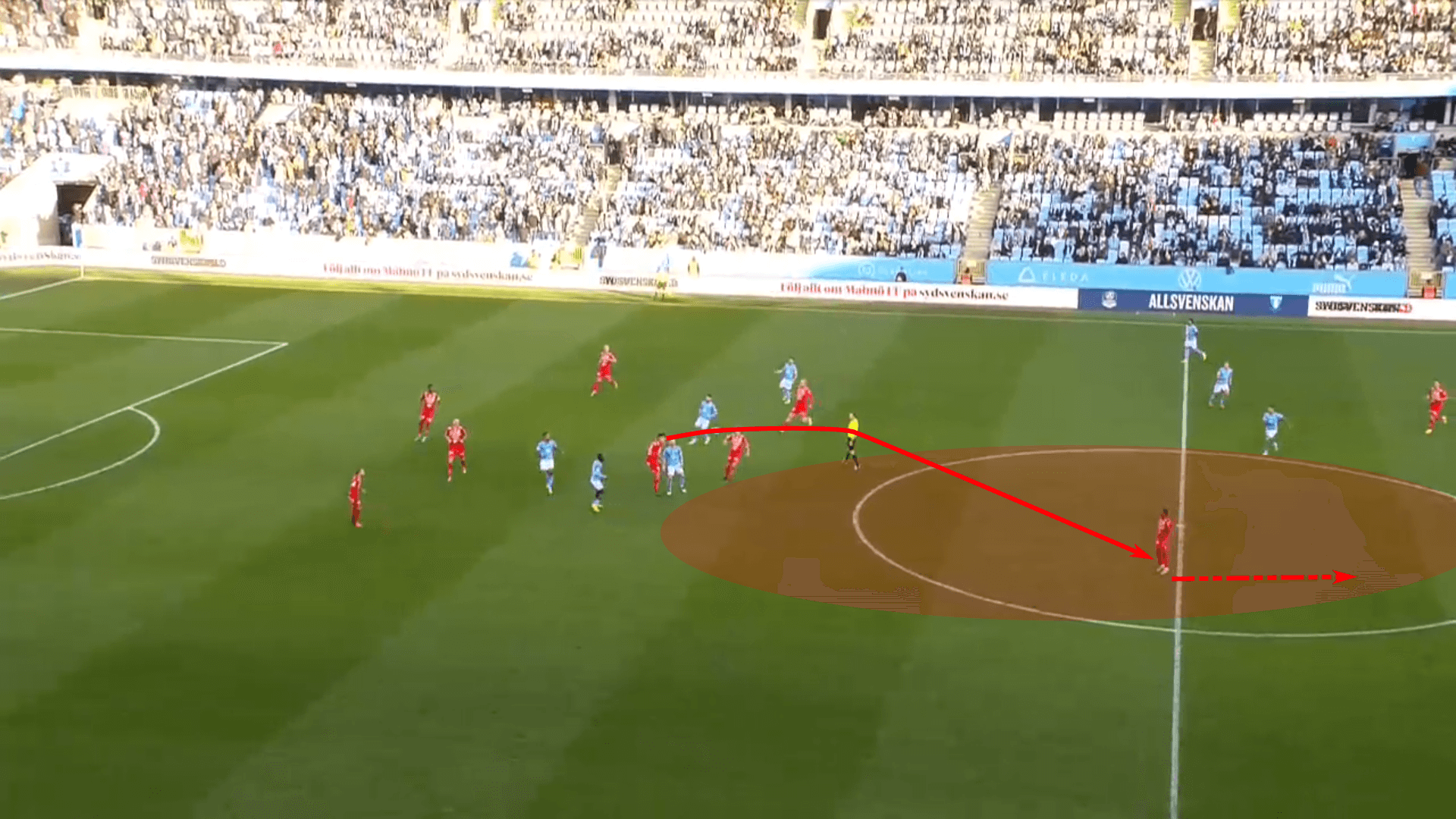
And this is where the connection of the game phases is so clearly seen in Hellberg’s philosophy.
Värnamo’s pressing structure is designed for a fluid move into attacking transitions.
Once the ball is won, the high central targets are in place and players behind the ball are racing forward into open space to support the counterattack.
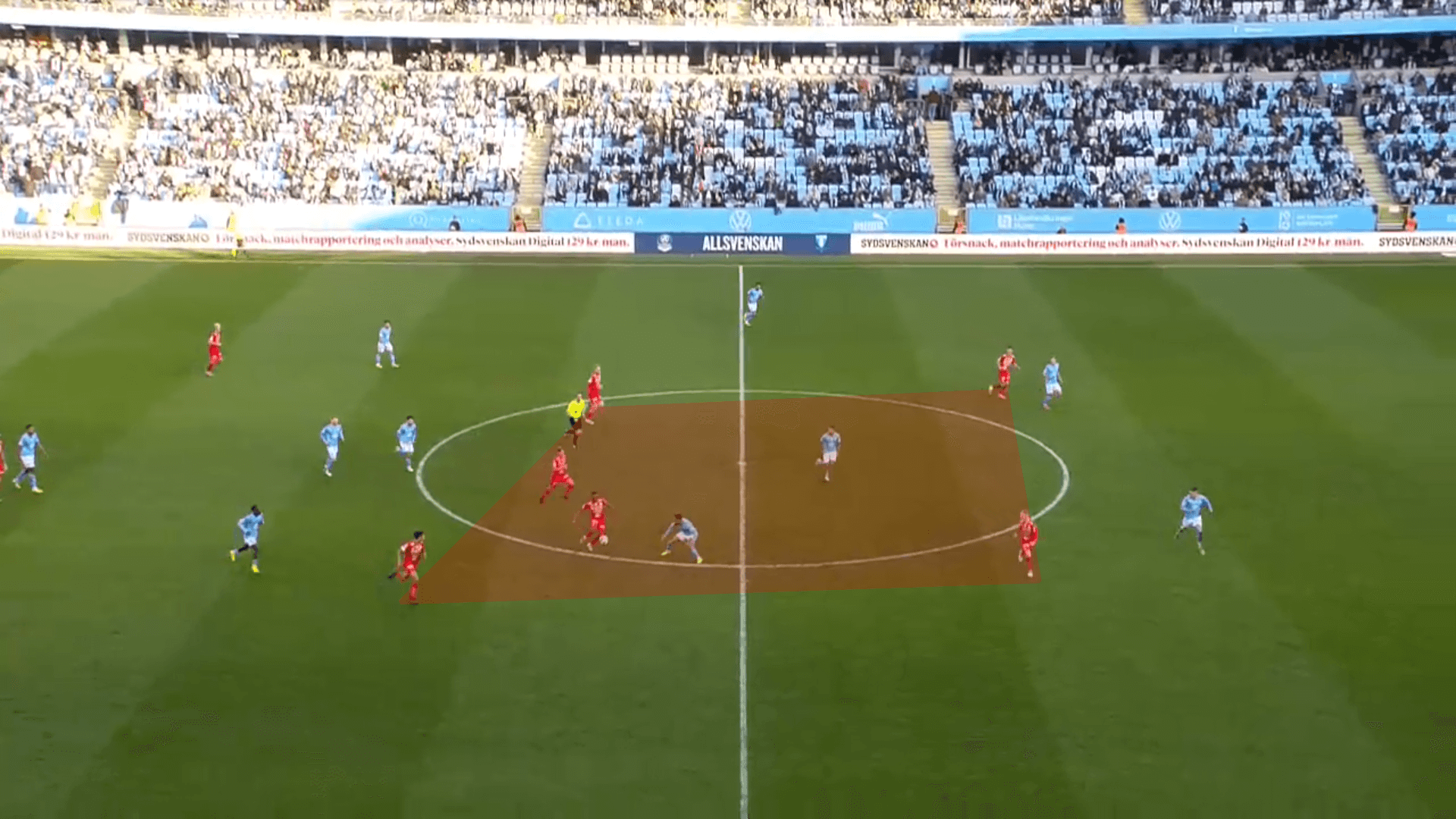
Värnamo pin the Malmö back, creating a 2v1 on the right.
The pass is a simple one, springing the winger behind the outside back.
Progression into the final third is secured and now attention turns to goal.
Once again, look at the numbers centrally.
Värnamo is ready for service into the box.
All that’s left to do is to coordinate the movements into the box.
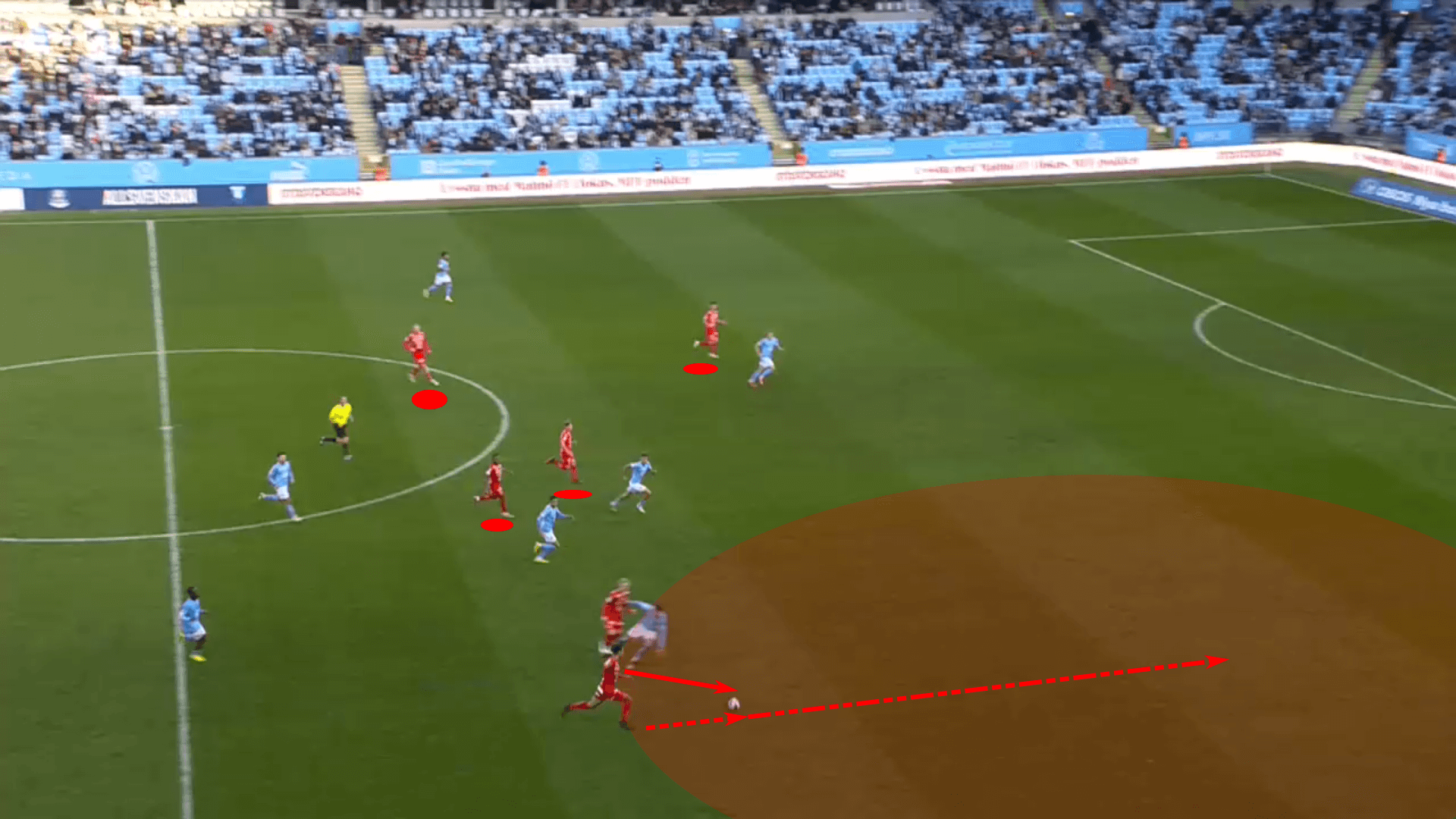
Though standard metrics for gauging pressing intensity will tell you Värnamo is a moderate pressing team, the structural design of Hellberg’s tactics tells another story.
Pressure on the first attacker comes when Värnamo has eliminated shortened intermediate options.
There’s a change in tempo as they engage.
A low-tempo start frustrates the opponent.
But with each negative pass, the Värnamo press gains intensity before picking out the moment to engage the opposing goalkeeper or centre-back, forcing them to operate as the deep playmaker.
Once the ball is won, we have the connection to the counterattack.
Tightly connected lines with central dominance which is supported by runs behind the backline and into the open space in the wings.
The move from open-play defending into attacking transitions is seamless, which is a credit to Hellberg and Selini, whose work on Total Football Analysis is linked here.
Conclusion
After a successful first season in the Allsvenskan, Hellberg returns to Värnamo looking to improve upon last season’s impressive performance and inch closer to the UEFA Europa League spots.
His tactics are unique in Sweden.
Even accounting for the core principles of his game model doesn’t necessarily help his opponents.
Hellberg’s side has shown they’re adept at switching approaches on the fly to account for threats and opportunities they encounter in the flow of play.
It’s a tactically intelligent team built for the contemporary game.
Hellberg’s star is rising in Sweden.
For anyone who enjoys tactical study and innovative teams, Hellberg and Värnamo are ones to watch in 2023.





Comments